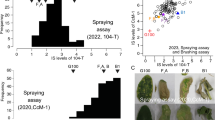Abstract
Stability of resistance to corn planthopper, Peregrinus maidis (Ashmead), was studied over three plant growth stages in 56 sorghum germplasm accessions. Genotype x stage interactions were significant. Plant age exerted a profound influence on the rate of o viposition, establishment of nymph, macropterous and brachypterous adult populations and plant damage. Resistance to corn planthopper was stable over three growth stages in IS 18557, IS 18677 and PJ 8K(R), which also supported low colonization of nymph and adult populations; IS 12308 was unstable due to high deviation. Significantly low rate of oviposition on resistant as compared to susceptible genotypes and the positive and significant correlation between oviposition and plant damage illustrated that antixenosis for oviposition is the primary mechanism of resistance. As a consequence the genotypes preferred for oviposition showed susceptibility due to higher plant damage. Establishment of nymphs was affected on the genotypes, IS 1054, IS 1082, IS 2194, IS 3992, IS 12308, IS 18676 and IS 19349 which may be due to the factors involved either in reduced hatchability of eggs and/or deterrence or poor feeding preference of nymphs.
Résumé
La stabilité de la résistance à la delphacide du maïs, Peregrinus maidis (Ashmead) a été étudiée sur 3 stades de développement des accessions du germplasme de sorgho. Les interactions génotype x stade sont significatives. L’âge de la plante exerce une grande influence sur le taux de l’oviposition, l’établissement des larves et des populations adultes de macroptères et de brachyptères et sur les dégâts. La résistance de la cicadelle du maïs est stable aux 3 stades de développement chez IS 18557, IS 18677 et PJ 8K(R); celles-ci enregistrent une colonisation faible de populations larvaires et imaginales. IS 12308 est instable en raison de l’écart type élevé. Le taux de l’oviposition sur les génotypes résistants comparés aux sensibles ainsi que la corrélation positive et significative entre l’oviposition et les dégâts sur les plantes, démontrent que l’antixenosis pour l’oviposition est le premier mécanisme de résistance. Comme conséquence, les génotypes préferés pour l’oviposition affichent une grande sensibilité au regard des dégâts sévères observés. L’établissement des larves est affecté sur les génotypes IS 1054, IS 1082, IS 2194, IS 3992, IS 12308, IS 18676 et IS 19349; ceci peut être dû aux facteurs impliqués soit dans la réducation des éclosions des oeufs, soit la déterrence ou la préférence alimentaire faible des larves.
Similar content being viewed by others
References
Ashmead W.H.(1890) Thecorndelphacid, Delphax maidis. Psyche 5, 167–168; 321–324.
Ayyar T. V. R. (1940) Handbook of Economic Entomology for South India. Superintendent, Govt. Press, Madras.
Chelliah S. and Basheer M. (1965) Biological studies of Peregrinus maidis (Ashmead (Araeopidae: Homoptera) on sorghum. Indian J. Entomol. 27, 466–471.
Choi S. Y., Lee S. W., Chung B. K. and Kim J. W. (1982) Varietal resistance of Korean new rice cultivars to the white backed planthopper, Sogatella furcifera (Horvath) III. Seoul Natl. Univ. Coll. Agric. Bull. 7, 36–40.
Eberhart S. A. and Russell W. A. (1966) Stability parameters for comparing varieties. Crop. Sci. 6, 36–40.
Fisk J. (1978) Resistance of Sorghum bicolor to Rhopalosiphum maidis and Peregrinus maidis as affected by differences in the growth of the host. Entomol. Exp. Appl. 23, 227–236.
Fisk J. (1980) Effect of HCN, phenolic acids and related compounds in Sorghum bicolor on the feeding behaviour of the planthopper, Peregrinus maidis. Entomol. Exp. Appl. 27, 211–222.
Fullaway D. T. (1918) The corn leafhopper, Peregrinus maidis (Ashm.). HawaiiBd. Agric. Forestry Div. Entomol. Bull. No. 4.
Khan Z. R. and Saxena R. C (1985) Behavioural and physiological responses of Sogatella furcifera (Homoptera: Delphacidae) to selected resistantand susceptible rice cultivars. J. Econ. Entomol. 78, 1280–1286.
Lefroy H. M. (1915) The more important insects injurious to Indian agriculture. Mem. Dept. Agric. Indian Entomol. Ser. 1.
Rana B.S., Jotwani M.G. and Rao N.G.P. (1981) Inheritance of host plant resistance to shootfly. Insect Sci. Applic. 2, 105–109.
Rao Y. R. (1923a) Life history of Pundaluoya simplica Distant. The cholam leafhopper. Madras Agric. Dept. Yearbk pp. 27–31.
Rao Y. R. (1923b) A note on the dimorphism in Pundaluoya simplica Dist. (Dicranotropis) maidis Ashm. Rep. Proc. 5th Entomol. Mfg. Pusa. pp. 406–408.
Rawat R. R. and Saxena D. K. (1967) Studies on the bionomics of Peregrinus maidis (Ashmead) (Homoptera: Araeopidae). JNKW Res. J. 1, 64–67.
Rodriguez-Rivera (1972) Resistance to whitebacked planthopper, Sogatella furcifera (Horvath) in rice varieties. M.Sc. Thesis, Univ. Philippines, Los Banös, Philippines.
Singh B. U. and Rana B. S. (1984) Influence of varietal resistance on oviposition and larval development of stalk-borer, Chilo partellus Swin., and its relationship to field resistance in sorghum. Insect Sci. Applic. 5, 287–296.
Singh S. P. and Jotwani M. G. (1980) Mechanism of resistance in sorghum to shootfly II. Antibiosis. Indian J. Entomol. 42, 352–360.
Woodhead S., Padgham D. and Bernays E. A. (1980) Insect feeding on different sorghum cultivars in relation to cyanide and phenolic acid content. Ann. Appl. Biol. 95, 151–157.
Author information
Authors and Affiliations
Rights and permissions
About this article
Cite this article
Singh, B.U., Rana, B.S. Stability of Resistance to Corn Planthopper, Peregrinus Maidis (Ashmead) in Sorghum Germplasm. Int J Trop Insect Sci 13, 251–263 (1992). https://doi.org/10.1017/S1742758400014430
Received:
Revised:
Published:
Issue Date:
DOI: https://doi.org/10.1017/S1742758400014430
Key Words
- Antixenosis
- corn planthopper
- mechanisms of resistance
- Peregrinus maidis
- resistance
- sorghum germplasm
- stability of resistance




